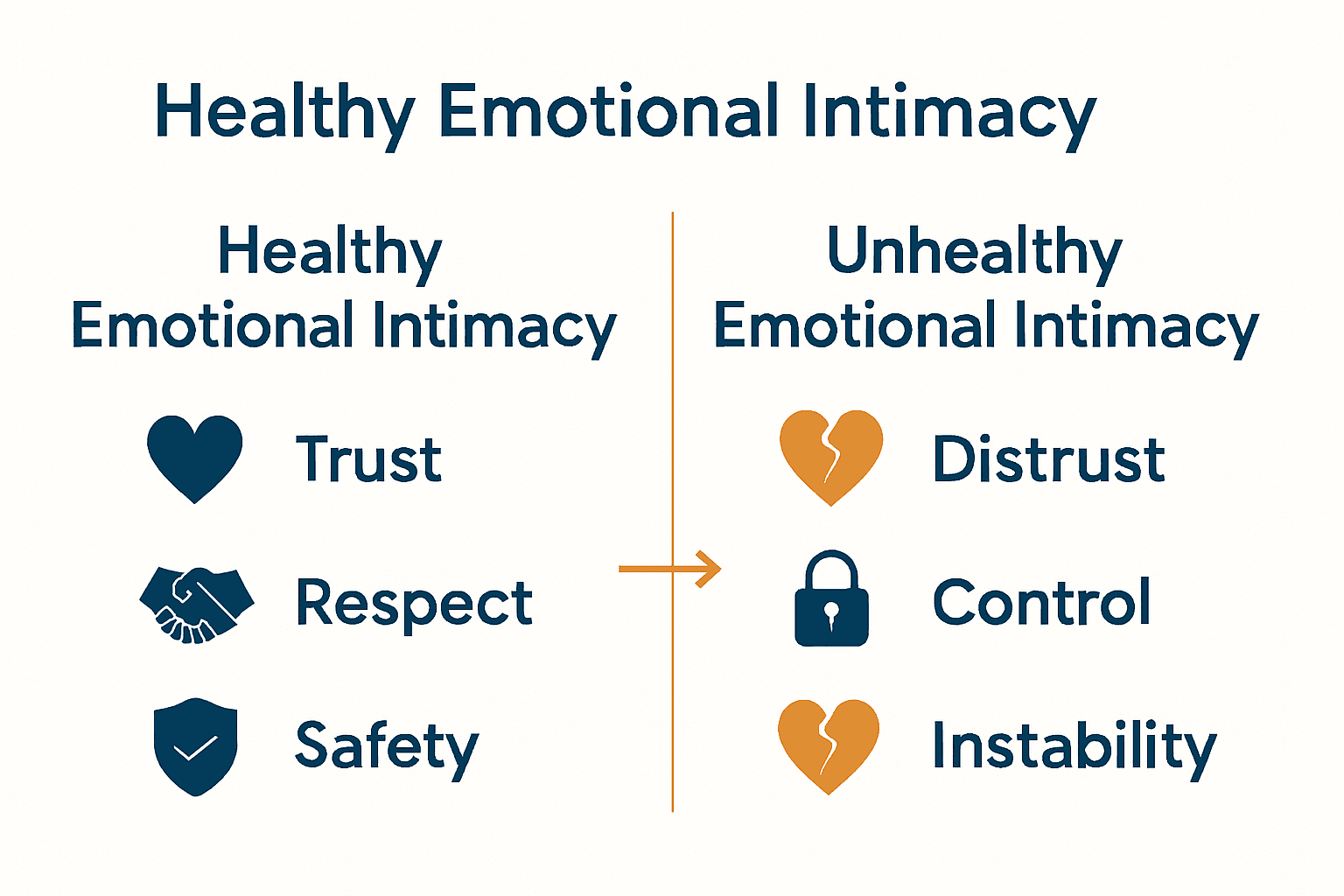What Is Emotional Intimacy? Complete Expert Guide
Nearly one in five adults reports feeling emotionally disconnected from their partner, even in long-term relationships. Emotional intimacy often gets overlooked or confused with physical closeness, leaving many people frustrated or misunderstood. Understanding the true nature of emotional intimacy can help you distinguish real connection from common myths and build relationships defined by trust, empathy, and lasting support.
Table of Contents
- Defining Emotional Intimacy And Common Misconceptions
- Types Of Emotional Intimacy In Relationships
- Core Characteristics And Developmental Stages
- Signs Of Healthy Vs. Unhealthy Intimacy
- Challenges, Barriers, And How To Improve Emotional Intimacy
Key Takeaways
| Point | Details |
|---|---|
| Emotional Intimacy Definition | Emotional intimacy involves deep closeness built through self-disclosure and responsive communication. It’s about vulnerability and trust, not just sharing personal details. |
| Types of Emotional Intimacy | Emotional intimacy encompasses various dimensions, including verbal, intellectual, experiential, and spiritual intimacy, each requiring distinct skills and approaches. |
| Characteristics of Healthy Intimacy | Healthy emotional intimacy features mutual trust, empathy, and active listening, facilitating a supportive environment for vulnerability and growth. |
| Challenges and Strategies | Key barriers to intimacy include unresolved traumas and communication deficits, with strategies such as active listening and gradual vulnerability recommended for improvement. |
Defining Emotional Intimacy and Common Misconceptions
Emotional intimacy is more complex than most people realize. According to Wikipedia, it involves deep feelings of closeness, connectedness, and bondedness in loving relationships, fundamentally built through self-disclosure and responsive communication.
Contrary to popular belief, emotional intimacy isn’t just about sharing personal details. It’s a nuanced process of creating vulnerability and trust between individuals. Wikipedia notes that some people struggle with intimacy due to past dysfunctional bonding experiences, which can trigger significant anxiety when attempting to exchange personal thoughts and feelings.
Common misconceptions about emotional intimacy include:
- Believing it’s identical to physical intimacy
- Thinking it happens automatically in relationships
- Assuming vulnerability means weakness
- Expecting instant deep connection without consistent effort
True emotional intimacy requires deliberate, consistent actions. Partners must create safe spaces where they can authentically share their inner worlds without judgment. This means actively listening, demonstrating empathy, respecting boundaries, and consistently showing emotional support. It’s a dynamic, evolving process that demands patience, self-awareness, and genuine commitment from both individuals.
Types of Emotional Intimacy in Relationships
Emotional intimacy is not a monolithic concept, but a complex landscape with multiple dimensions. Choosing Therapy highlights that relationships involve several interconnected types of intimacy, each playing a unique role in building deep connections.
The primary types of emotional intimacy include:
- Verbal Intimacy: Sharing thoughts, feelings, and personal experiences through open communication
- Intellectual Intimacy: Exchanging ideas, engaging in meaningful discussions, and respecting each other’s perspectives
- Experiential Intimacy: Creating shared memories and participating in activities that strengthen mutual understanding
- Spiritual Intimacy: Connecting on deeper philosophical, existential, or religious levels
Each type of intimacy requires different skills and approaches. Verbal intimacy demands vulnerability and active listening, while intellectual intimacy requires mutual respect and genuine curiosity about each other’s inner worlds. Experiential intimacy involves creating meaningful shared experiences, and spiritual intimacy connects partners through deeper existential conversations and shared values.
Here’s a comparison of different types of emotional intimacy in relationships:
| Type of Intimacy | Main Focus | Key Behaviors |
|---|---|---|
| Verbal Intimacy | Sharing thoughts and feelings | Open communication Active listening |
| Intellectual Intimacy | Exchanging ideas, perspectives | Respectful debate Stimulating discussion |
| Experiential Intimacy | Shared activities and experiences | Creating memories Mutual participation |
| Spiritual Intimacy | Connecting on deeper values and beliefs | Philosophical talks Shared rituals |
Building these various forms of emotional intimacy is not a linear process. It requires ongoing commitment, patience, and a willingness to be authentic. Partners must consistently create safe emotional spaces, practice empathetic communication, and demonstrate genuine interest in understanding each other’s complex inner landscapes. By recognizing and nurturing these different types of intimacy, couples can develop more profound, resilient, and fulfilling relationships.

Core Characteristics and Developmental Stages
Emotional intimacy is a dynamic process with distinct developmental characteristics. Wikipedia describes intimacy as a core component of love, involving deep feelings of closeness and connectedness that emerge through mutual self-disclosure and shared experiences.
Developmental stages of emotional intimacy typically progress through several key phases:
- Initial Exploration: Cautious sharing of surface-level personal information
- Gradual Vulnerability: Increasing willingness to reveal deeper emotional experiences
- Mutual Trust Building: Developing consistent emotional safety and reliability
- Deep Connection: Achieving profound understanding and authentic emotional resonance
According to Cognitive Valence Theory, individuals respond to intimacy behaviors through complex cognitive schemata, which means emotional intimacy isn’t just about sharing, but how those shares are perceived and processed. Some interactions will create positive relational outcomes, while others might trigger defensive responses.
The core characteristics of healthy emotional intimacy include genuine empathy, consistent emotional availability, active listening, non-judgmental acceptance, and the ability to maintain personal boundaries while remaining connected. Partners who successfully navigate these characteristics create relationships marked by deep understanding, mutual respect, and emotional resilience. This journey requires continuous effort, self-awareness, and a commitment to personal and relational growth.
Signs of Healthy vs. Unhealthy Intimacy
Healthline provides critical insights into the fundamental differences between healthy and unhealthy emotional intimacy. At its core, emotional intimacy is about creating a safe, supportive environment where both partners can be authentically vulnerable and deeply understood.
Signs of Healthy Emotional Intimacy:
- Mutual trust and consistent emotional reliability
- Open and honest communication
- Respectful boundaries and personal autonomy
- Genuine empathy and active listening
- Comfort with vulnerability
- Shared positive experiences and mutual growth
In contrast, Wikipedia reveals that unhealthy intimacy often stems from deep-seated fears of closeness, which can manifest as significant relationship challenges. Signs of Unhealthy Emotional Intimacy include:
- Persistent emotional distance
- Inability to share genuine feelings
- Frequent defensiveness or emotional withdrawal
- Manipulative communication patterns
- Lack of trust and constant suspicion
- Unresolved past trauma interfering with connection
Navigating emotional intimacy requires self-awareness, intentional communication, and a commitment to personal and relational healing. Partners must recognize their own patterns, acknowledge vulnerabilities, and consistently work towards creating a safe, nurturing emotional landscape. For those struggling with understanding healthy relationship dynamics, our key differences between healthy and unhealthy anger guide can provide additional insights into building more authentic connections.

Challenges, Barriers, and How to Improve Emotional Intimacy
Healthline reveals that emotional intimacy is fraught with complex challenges that can derail even the most well-intentioned relationships. Understanding these barriers is the first critical step toward creating deeper, more meaningful connections.
Common Challenges in Emotional Intimacy:
- Unresolved past traumas
- Communication skill deficits
- Fear of vulnerability
- Misaligned emotional expectations
- Previous relationship wounds
- Chronic stress and external pressures
Wikipedia highlights that fear of closeness represents a significant barrier to emotional intimacy, often rooted in deep psychological patterns. This fear can manifest as emotional withdrawal, persistent defensiveness, or an inability to genuinely connect.
Strategies for Improving Emotional Intimacy:
- Practice intentional, active listening
- Create consistent, safe communication spaces
- Gradually increase emotional vulnerability
- Address unresolved personal traumas
- Develop mutual empathy and understanding
For couples seeking to enhance their emotional connection, our guide on understanding emotional intimacy in marriage provides practical insights into building stronger, more resilient relationships. Improving emotional intimacy is a journey of mutual growth, requiring patience, commitment, and a willingness to be authentically vulnerable with one another.
Build True Emotional Intimacy With Expert Support
Emotional intimacy is a vital foundation for fulfilling relationships but many struggle with fear of vulnerability, unresolved trauma, or communication barriers. If you feel stuck in patterns of emotional distance or want to deepen your connection through trust and empathy, you are not alone. The journey from cautious sharing to a deep authentic bond requires guidance and consistent effort to overcome challenges like fear of closeness and lack of emotional safety.

Start strengthening emotional intimacy today with personalized support from Mastering Conflict. Our services include couples therapy and individual counseling designed to help you build active listening skills, create safe spaces, and nurture genuine empathy. Discover practical strategies to navigate developmental stages of intimacy and replace unhealthy patterns with trust and open communication. Visit us now to learn about our therapeutic approaches and how to take the first step toward resilient, fulfilling relationships.
Frequently Asked Questions
What is emotional intimacy?
Emotional intimacy is a complex form of closeness that involves deep feelings of connection, trust, and vulnerability between individuals, built through self-disclosure and responsive communication.
How can I improve emotional intimacy in my relationship?
Improving emotional intimacy requires consistent effort, including practicing active listening, creating safe communication spaces, gradually increasing vulnerability, and developing mutual empathy and understanding.
What are the signs of healthy emotional intimacy?
Signs of healthy emotional intimacy include mutual trust, open communication, respect for boundaries, genuine empathy, comfort with vulnerability, and shared positive experiences.
What challenges can hinder emotional intimacy?
Common challenges include unresolved past traumas, deficits in communication skills, fear of vulnerability, misaligned emotional expectations, and chronic stress, which can lead to emotional withdrawal or defensiveness.
Recommended
- Understanding Emotional Intimacy in Marriage – Mastering Conflict
- 7 Essential Tips for Developing Emotional Intelligence – Mastering Conflict
- Mastering Empathy in Conflict Resolution: A Step-by-Step Guide – Mastering Conflict
- Dealing with Difficult Emotions: Mastering Your Reactions – Mastering Conflict
- What Is Emotional Intelligence? Complete Breakdown – Wisdom

